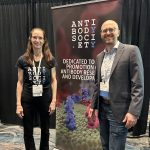As an international non-profit supporting antibody related research and development, we invite you to explore our extensive resources and the latest insights in the field.
Learn more about what we offer:
- The latest research and breakthroughs in antibody science.
- Educational webinars and symposia.
- Networking opportunities with our society members.
- Access to the Adaptive Immune Receptor Repertoire (AIRR) Community.
Whether you’re a long-time member or a first-time visitor, there’s something here for everyone passionate about antibody research and development.
Attending AE&T 2024?
We’re happy to be a proud scientific program partner at AE&T 2024 in San Diego from December 15-18! If you’re around, we’d love to connect with you at our booth (#113). Stop by to grab a goodie and learn more about the latest in Antibody Engineering and Therapeutics.
If you’re in or around the San Diego area and are a member of The Antibody Society, don’t forget that TAbS members receive a 15% discount on registration for all AE&T meetings! For more information about AE&T San Diego 2024, visit: https://informaconnect.com/antibody-engineering-therapeutics/ we look forward to seeing you there!
Not a member yet?
If you’re an employee of one of our corporate sponsors, you can sign up for free and gain access to all the exclusive resources and benefits available to our members. If you’re not an employee of a corporate sponsor and are interested in getting involved, explore our membership levels and sign up today to become part of a global community dedicated to advancing antibody science.
Happy Holidays!



